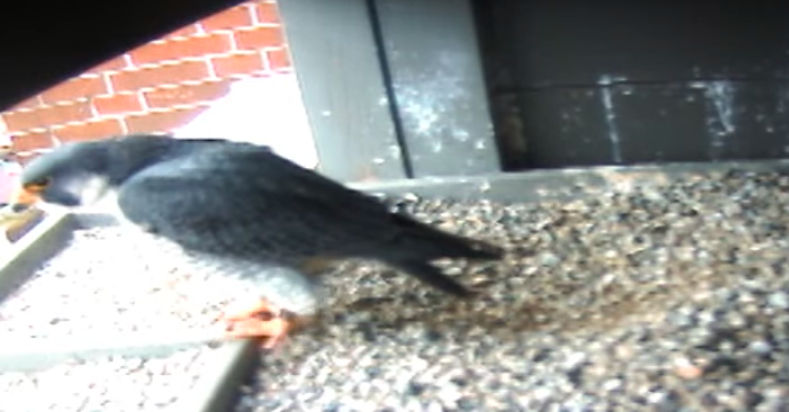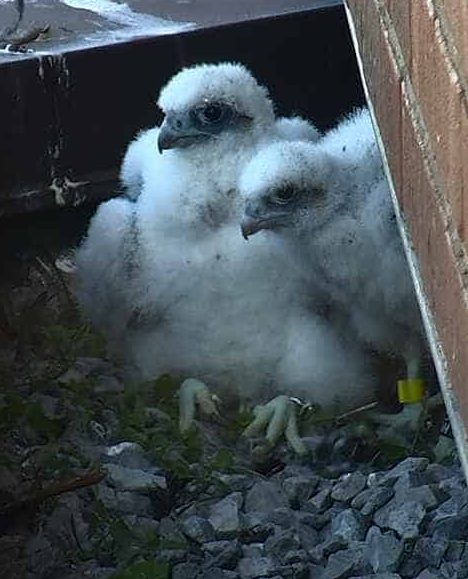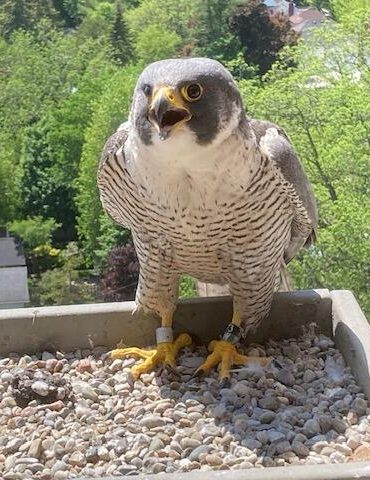VIDEO: Peregrine falcons return to Lakeridge Health Oshawa nest
Published March 22, 2024 at 12:21 pm

After spending the winter abroad, the Peregrine Falcons who call Oshawa’s Lakeridge Health Hospital home have returned to their nest.
The hospital has hosted Peregrines for more than a decade to provide the birds a nesting place and a home to hatch their chicks. The last pair of chicks, Olive and Elding, were born last May.
After the chicks hatch, members of the Canadian Peregrine Foundation climb up to the precarious ledge the falcons use. The members band and weigh the chicks to monitor their development. Environment Canada is usually also hand to take a blood sample to monitor for toxins.

The Falcons at Lakeridge are part of an effort to reintroduce peregrines to the area.
Canadian Peregrines belong to the Falco peregrinus anatum subspecies. Decades ago, these peregrines roamed all across North America from the tundra to northern Mexico.
Some vagrant birds have even made their way to Europe, though this is highly unusual. European and Asian peregrines belong to their own subspecies.
However, like Bald Eagles, the peregrine population was nearly wiped out by exposure to pesticides, most infamously DDT. These chemicals weakened the bird’s eggshells leading nesting mothers to crush their own eggs.

Alfreida is the resident peregrine falcon at Lakeridge Health Oshawa.
The population struggled throughout the 1950s to the 1970s and even became locally extinct in much of the United States. Eventually, peregrines were only found in the Canadian Rocky Mountains for a time.
The pesticides causing the crisis were finally banned globally through the late 70s and early 80s. Falcon populations didn’t rebound on their own though. For a time many birds had to be bred in captivity and released back into the wild.
Over the last 40 years, the chemicals have left the birds enough for them to more successfully breed in the wild, though toxin counts remain high in the birds.
Recovery efforts have been highly successful with peregrine taken off the Endangered Species list in 1999. They were marked as no longer at risk in 2014.
This recovery took a lot of work for humans to accomplish. Marion Nash of the Canadian Peregrine Foundation credited the hospital with the success of the Lakeridge nest.
“Their tremendous support has made a big difference in the survival of these falcons and management of this nest site,” she told Insauga on banding day last week.
The nesting site on the hospital was chosen by the falcons to begin with. Staff were working on the roof years ago when resident falcon Alfrieda and her mate attacked them.
Now when the falcons return, the hospital postpones all work on the roof. If they really have to go up there, they bring a distraction broom for the birds to attack.
Peregrines mate for life following a dramatic courtship where the falcons fly around each other acrobatically including spirals and deep dives. Often the male will give the female some prey, at which time the female flies upside down to eat from the male’s talons.
During the breeding season the pair grows fiercely territorial, with each pair living at leadt a kilometre apart, though often much more.
Peregrines will fight creatures much larger than themselves to protect their eggs including owls, herons, and even foxes, wolves and bears if their nest is near the ground. They’ve been recorded killing Bald and Golden Eagles in defence of their nests, both of which are more than twice the falcon’s size.
Peregrines usually lay their eggs between February and March, which they incubate for about a month. The chicks will be capable of flight about six weeks later and leave the nest a few months after that.
insauga's Editorial Standards and Policies advertising





